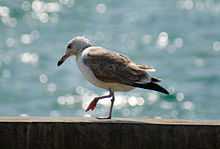Pallas's gull
| Pallas's gull | |
|---|---|
_W_IMG_6665.jpg) | |
| in Krishna Wildlife Sanctuary, Andhra Pradesh, India. | |
| Conservation status | |
| Scientific classification | |
| Kingdom: | Animalia |
| Phylum: | Chordata |
| Class: | Aves |
| Order: | Charadriiformes |
| Family: | Laridae |
| Genus: | Ichthyaetus |
| Species: | I. ichthyaetus |
| Binomial name | |
| Ichthyaetus ichthyaetus (Pallas, 1773, Caspian Sea) | |
| Synonyms | |
|
Larus ichthyaetus | |
The Pallas's gull or great black-headed gull (Ichthyaetus ichthyaetus) is a large gull. As is the case with many gulls, it has traditionally been placed in the genus Larus.[2]
This species breeds in colonies in marshes and islands from southern Russia to Mongolia. It is migratory, wintering in the eastern Mediterranean, Arabia and India. This gull nests on the ground, laying between two and four eggs.
It occurs in western Europe only as a rare vagrant. In Great Britain a recent review left a single occurrence in 1859 as the only acceptable record of this bird. The species also occurs as a vagrant in differing parts of the Indian Ocean, south of its normal range, and along the northern and eastern coasts of Africa, where it visits annually on an irregular basis.[3]

This is a very large gull, being easily the world's largest black-headed gull and the third largest species of gull in the world, after the great black-backed gull and the glaucous gull. It measures 55–72 cm (22–28 in) in length with a 142 to 170 cm (56 to 67 in) wingspan.[4][5][6] Weight can vary from 0.96–2.1 kg (2.1–4.6 lb), with an average of 1.6 kg (3.5 lb) in males and 1.22 kg (2.7 lb) in females.[7] Among standard measurements, the wing chord is 43.5 to 52 cm (17.1 to 20.5 in), the bill is 4.7 to 7.3 cm (1.9 to 2.9 in) and the tarsus is 6.5 to 8.4 cm (2.6 to 3.3 in).[5] Summer adults are unmistakable, since no other gull of this size has a black hood. The adults have grey wings and back, with conspicuous white "mirrors" at the wing tips. The legs are yellow and the bill is red.
In all other plumages, a dark mask through the eye indicates the vestiges of the hood. The call is a deep aargh cry. Young birds attain largely grey upperparts quite rapidly, but they take four years to reach maturity.
These birds are predatory, taking fish, crustaceans, insects and even small mammals.
The Pallas's gull is one of the species to which the Agreement on the Conservation of African-Eurasian Migratory Waterbirds (AEWA) applies.
This bird has a deep, rather nasal flight-call which resembles the call of the lesser black-backed gull. Although they are noisy at colonies, Pallas's gulls are mostly silent when breeding.
References
- ↑ BirdLife International (2004). Larus ichthyaetus. 2006. IUCN Red List of Threatened Species. IUCN 2006. www.iucnredlist.org. Retrieved on 11 May 2006.
- ↑ Pons J.M., Hassanin, A., and Crochet P.A.(2005). Phylogenetic relationships within the Laridae (Charadriiformes: Aves) inferred from mitochondrial markers. Molecular phylogenetics and evolution 37(3):686-699
- ↑ Field Guide to the Birds of East Africa: Kenya, Tanzania, Uganda, Rwanda, Burundi by Stevenson & Fanshawe. Elsevier Science (2001), ISBN 978-0856610790
- ↑ Sergey Panayotov /. "Birds in Bulgaria". Birds in Bulgaria. Retrieved 2011-10-19.
- ↑ 5.0 5.1 Gulls: Of North America, Europe, and Asia by Klaus Malling Olsen & Hans Larsson. Princeton University Press (2004). ISBN 978-0691119977.
- ↑ Harrison, Peter, Seabirds: An Identification Guide. Houghton Mifflin Harcourt (1991), ISBN 978-0-395-60291-1
- ↑ CRC Handbook of Avian Body Masses by John B. Dunning Jr. (Editor). CRC Press (1992), ISBN 978-0-8493-4258-5.
Gallery
-
_after_catching_a_prey_W_IMG_6953.jpg)
after catching a prey in Krishna Wildlife Sanctuary, Andhra Pradesh, India.

_W_IMG_6955.jpg)
_W_IMG_6954.jpg)
_W_IMG_6952.jpg)
_W_IMG_6667.jpg)